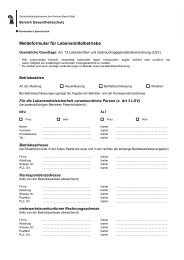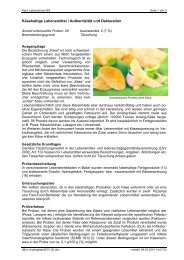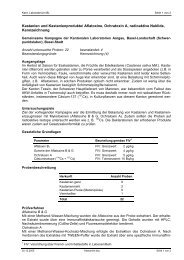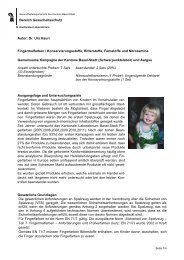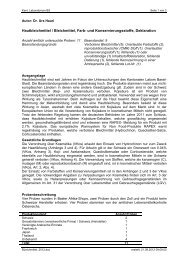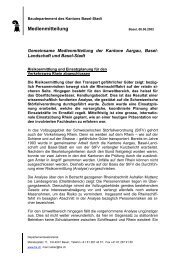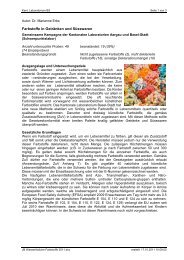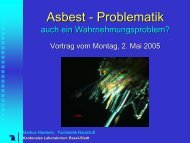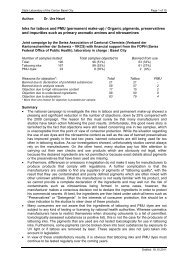Composition of and declaration for chewing gum
Composition of and declaration for chewing gum
Composition of and declaration for chewing gum
You also want an ePaper? Increase the reach of your titles
YUMPU automatically turns print PDFs into web optimized ePapers that Google loves.
<strong>Composition</strong> <strong>of</strong> <strong>and</strong> <strong>declaration</strong> <strong>for</strong> <strong>chewing</strong> <strong>gum</strong><br />
Joint campaign <strong>for</strong> Basel City (main laboratory) <strong>and</strong> Basel Country<br />
Number <strong>of</strong> samples investigated: 43 complained about: 13<br />
Grounds <strong>for</strong> complaint: composition (4), <strong>declaration</strong> (11)<br />
Background<br />
The first <strong>chewing</strong> <strong>gum</strong> was sold in New York in 1869. Chewing <strong>gum</strong>s essentially consist <strong>of</strong> a<br />
chewable base. In normal <strong>chewing</strong> <strong>gum</strong>, the wax element predominates, whereas in bubble <strong>gum</strong> it is<br />
the rubber-like substances that predominate. To be able to work the base into a homogeneous,<br />
plastic mass, it must be heated to about 60°C be<strong>for</strong>e being kneaded together with the sugar<br />
components. The addition <strong>of</strong> glycerine (E422) makes the mass more workable. Be<strong>for</strong>e the addition <strong>of</strong><br />
the sensitive ingredients <strong>and</strong> rolling out, the mass is cooled again to 30°C.<br />
More than a half <strong>of</strong> all <strong>chewing</strong> <strong>gum</strong>s on the market are sugar-free, i.e. they contain sugar alcohols<br />
instead <strong>of</strong> glucose <strong>and</strong> saccharose. Although these sugar substitutes do not have significantly fewer<br />
calories than the corresponding sugars, they exhibit less marked cariogenicity <strong>and</strong> barely affect blood<br />
sugar levels. Their relative sweetness is slightly less than that <strong>of</strong> saccharose. Sweeteners such as<br />
aspartame <strong>and</strong> acesulfam K are sometimes also present. These additives are likewise non-cariogenic<br />
<strong>and</strong> as it were calorie-free.<br />
Chewing <strong>gum</strong>s are being marketed increasingly frequently (mostly at a significantly higher price)<br />
which, based on certain claims or presentations, are extolled as “teeth-cleaning <strong>chewing</strong> <strong>gum</strong>s”. In<br />
principle, all sugar-free <strong>chewing</strong> <strong>gum</strong>s are “teeth-cleaning” <strong>chewing</strong> <strong>gum</strong>s. Whether additives such as<br />
carbamide or special mineral salts have added benefits <strong>for</strong> teeth is still a matter <strong>of</strong> debate.<br />
Aims <strong>of</strong> the investigation<br />
Chewing <strong>gum</strong>s have rarely been analysed in recent years. The aim <strong>of</strong> the investigation was to<br />
determine sugar alcohols, sweeteners, sugar, colouring agents, minerals, carbamide <strong>and</strong> glycerine.<br />
The marketing <strong>of</strong> increasingly novel <strong>chewing</strong> <strong>gum</strong>s, particularly those claimed to have medicinal<br />
properties, also calls <strong>for</strong> stringent checking <strong>of</strong> the <strong>declaration</strong>s provided <strong>for</strong> such products.<br />
Legal principles<br />
Chewing <strong>gum</strong>s are not explicitly mentioned in the Swiss Food Ordinance (LMV). Nevertheless,<br />
<strong>chewing</strong> <strong>gum</strong>s are classed as foodstuffs. Claims <strong>of</strong> medicinal benefits are thus also prohibited <strong>for</strong><br />
these products under Article 19 <strong>of</strong> the LMV. According to the Federal Rules <strong>and</strong> Regulations on<br />
Ingredients <strong>and</strong> Additives (FRRIA), <strong>chewing</strong> <strong>gum</strong>s that contain sugar are classed with cake <strong>and</strong> sugar<br />
products (22.1.7), while sugar-free <strong>chewing</strong> <strong>gum</strong>s are classed with special foods (17.2.2.3). Permitted<br />
additives are listed in the usage list in the FRRIA (Annex 1 C).<br />
Sugar alcohols may lead to flatulence <strong>and</strong> diarrhoea. As a result, the <strong>declaration</strong> “may have a laxative<br />
effect if consumed to excess” is to be quoted where these sugar substitutes are employed.<br />
The amino acid phenylalanine is problematic <strong>for</strong> patients with the metabolic disease phenylketonuria.<br />
The phrase “contains phenylalanine” must there<strong>for</strong>e be cited <strong>for</strong> products containing aspartame.<br />
Sample description<br />
43 different <strong>gum</strong>s with (9) or without (34) sugar, whether <strong>of</strong> the <strong>chewing</strong> (32) or bubble (11) <strong>gum</strong> type,<br />
were obtained from various kiosks <strong>and</strong> major distributors. They were produced in Switzerl<strong>and</strong> (11) <strong>and</strong><br />
other countries (32).<br />
Test method<br />
Sugar alcohols, sugar, carbamide <strong>and</strong> glycerine were analysed via the ion chromatograph. HPLC<br />
(high-pressure liquid chromatography) allows <strong>for</strong> analysis <strong>of</strong> the colouring agents <strong>and</strong> sweeteners.<br />
The concentrations <strong>of</strong> minerals are determined via inductively coupled plasma-mass spectrometry<br />
(ICP-MS).<br />
Results<br />
Four samples were the subject <strong>of</strong> complaints on compositional grounds: one <strong>chewing</strong> <strong>gum</strong> specified<br />
xylitol as the third ingredient on the list <strong>of</strong> ingredients. However, this sugar alcohol was undetectable.
Tartrazine (E102) was detected in the yellow pellets <strong>of</strong> another <strong>chewing</strong> <strong>gum</strong>. This azoic dye is<br />
currently not licensed in Switzerl<strong>and</strong>. This colouring agent is particularly a problem when, as here, it<br />
goes undeclared. There are people who react allergically to this substance <strong>and</strong> thus rely on a full<br />
<strong>declaration</strong> <strong>of</strong> ingredients. One sugar-free bubble <strong>gum</strong> <strong>for</strong> children contained acesulfam K without a<br />
corresponding <strong>declaration</strong> <strong>of</strong> this sweetener. One <strong>chewing</strong> <strong>gum</strong> contained 10 times the level <strong>of</strong><br />
calcium declared, which likewise prompted a complaint.<br />
Calcium contents were claimed <strong>for</strong> five <strong>chewing</strong> <strong>gum</strong>s. The quantities declared ranged between 230<br />
<strong>and</strong> 513 mg calcium per 100 g, equivalent to a quantity <strong>of</strong> between 4.3 <strong>and</strong> 5.9 mg calcium per<br />
<strong>chewing</strong> <strong>gum</strong> (i.e. only around 0.6% <strong>of</strong> the recommended daily dose). By way <strong>of</strong> comparison, one<br />
decilitre <strong>of</strong> milk or 100 g <strong>of</strong> yoghurt contain 120 mg calcium. It should be pointed out that many other<br />
(cheaper) <strong>chewing</strong> <strong>gum</strong>s contain just as much calcium without claiming this.<br />
Eight packs <strong>of</strong> <strong>chewing</strong> <strong>gum</strong> were “adorned” with phrases such as “reduces plaque” <strong>and</strong> “neutralises<br />
acids that destroy tooth enamel” or with attractive “pseudo-scientific” diagrams. Such “medicinal<br />
claims” have no business on foodstuffs, even if certain neutralising effects have been demonstrable.<br />
Five <strong>chewing</strong> <strong>gum</strong>s are marketed with the label “carbamide”. The question is whether the consumer<br />
would pay the higher price if he knew that the substance in question is merely urea.<br />
Conclusions<br />
Chewing sugar-free <strong>chewing</strong> <strong>gum</strong> after every meal can certainly be recommended or even promoted.<br />
The diagram showing the “little tooth man” in the “tooth-friendly” campaign can be helpful when<br />
selecting tooth-friendly foodstuffs. Tooth-friendly means that the product is neither cariogenic nor<br />
erosive. Pro<strong>of</strong> that both requirements are met must be provided in a scientific test. Chewing <strong>gum</strong> is<br />
effective mainly because food residues are mechanically removed from the teeth during the <strong>chewing</strong><br />
process. The saliva flow thus induced supports natural remineralisation <strong>and</strong> neutralisation <strong>of</strong> the acids<br />
produced by plaque bacteria from sugar.<br />
However, the consumer should not be deceived by the medicinal claims, pretty diagrams <strong>and</strong> phrases<br />
such as “carbamide”, “calcium”, “white” <strong>and</strong> “strong teeth”.



